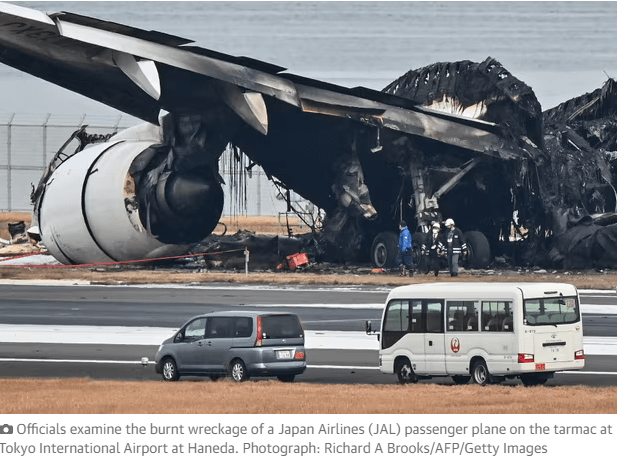Decoding the Japan Plane Crash: Unraveling the Mystery Behind the Non-Explosive Impact

In a remarkable incident at Haneda airport, Japan Airlines Flight 516, an Airbus A350-900, collided with a coast guard plane, leading to a fiery scene. Astonishingly, all 379 passengers and crew members not only escaped alive but did so with minimal harm. The burning question arises: why didn’t the jet explode on impact? Let’s delve into the expert analysis and key factors that played a role in this fortunate outcome.
On a Tuesday evening around 5:45 pm, the Airbus A350-900, departing from Sapporo, collided with a smaller Dash 8 aircraft while landing at Haneda airport. Tragically, five of the six individuals aboard the Dash 8 lost their lives. Despite the engulfing fire, the A350 avoided an explosion, showcasing a unique turn of events.
Dr. Sonya Brown, a senior lecturer in aerospace design at the University of New South Wales, sheds light on the aircraft’s construction. The A350 incorporates approximately 50% carbon fiber reinforced polymers, a high proportion in aviation history. While carbon fiber composites burn more easily than traditional materials like aluminum, steel, and titanium, their impact on the fire’s outcome is nuanced.
Brown explains that the fire, primarily located on the left wing, demonstrated the resilience of firewalls, designed to withstand high temperatures. This containment allowed for the orderly evacuation of passengers, exceeding the typical 90-second benchmark, considering the limitations posed by doors above the wings.
Job vacancies decrease for the fifth consecutive quarter, says StatCan
Addressing concerns about material performance, Brown highlights that carbon fiber composites start losing stiffness at lower temperatures compared to aluminum. Despite this, the intense fire, reaching temperatures above 1000 degrees Celsius, would not alter the overall outcome. The fire’s concentration on the left wing, thanks to the strategically placed firewalls, played a pivotal role in preventing a more catastrophic scenario.
Neil Hansford, an industry consultant at Strategic Aviation Solutions, emphasizes the role of fuel efficiency in averting a potential explosion. Commercial aircraft typically carry the fuel required for the trip plus a 10% buffer. This industry rule ensures that the exterior may burn out over time, but interiors are designed with fire-resistant materials, allowing for a more controlled evacuation.
Hansford clarifies that the relatively low amount of jet fuel during landing minimized the fire’s intensity, reducing the risk of an explosion. The adherence to industry regulations regarding fuel load further contributed to the controlled aftermath of the incident.
In unraveling the intricacies of the Japan plane crash, the combination of advanced materials, strategic design, and adherence to industry regulations emerges as the hero of the story. The resilience of carbon fiber composites, coupled with meticulous safety measures, played a crucial role in ensuring the survival of all on board. This incident serves as a testament to the continuous evolution of aviation engineering and the commitment to passenger safety.




